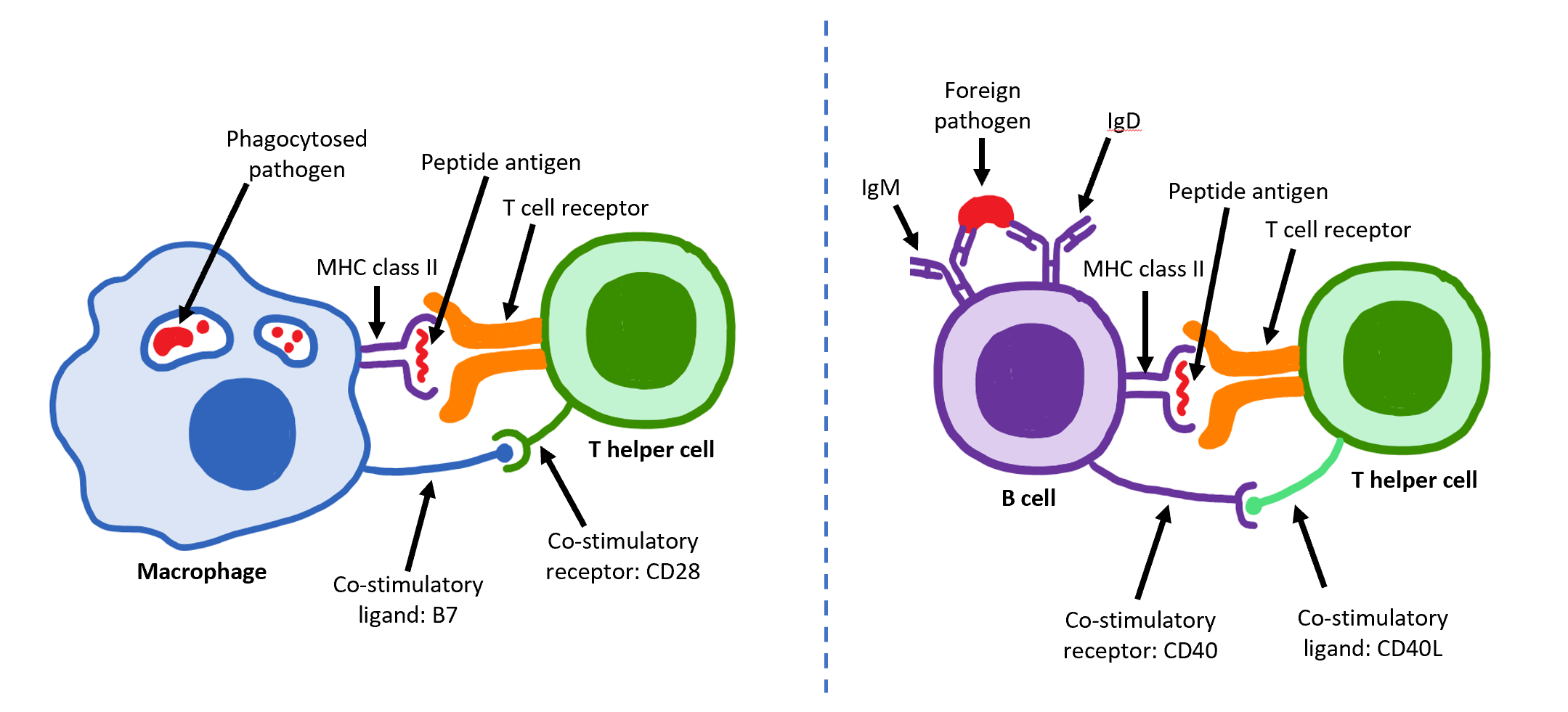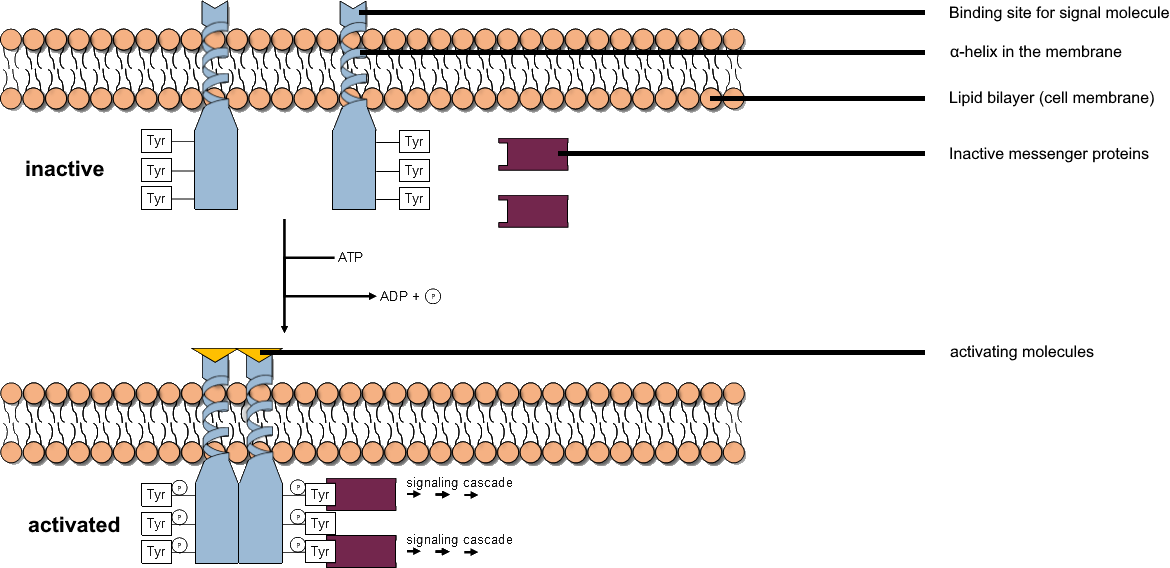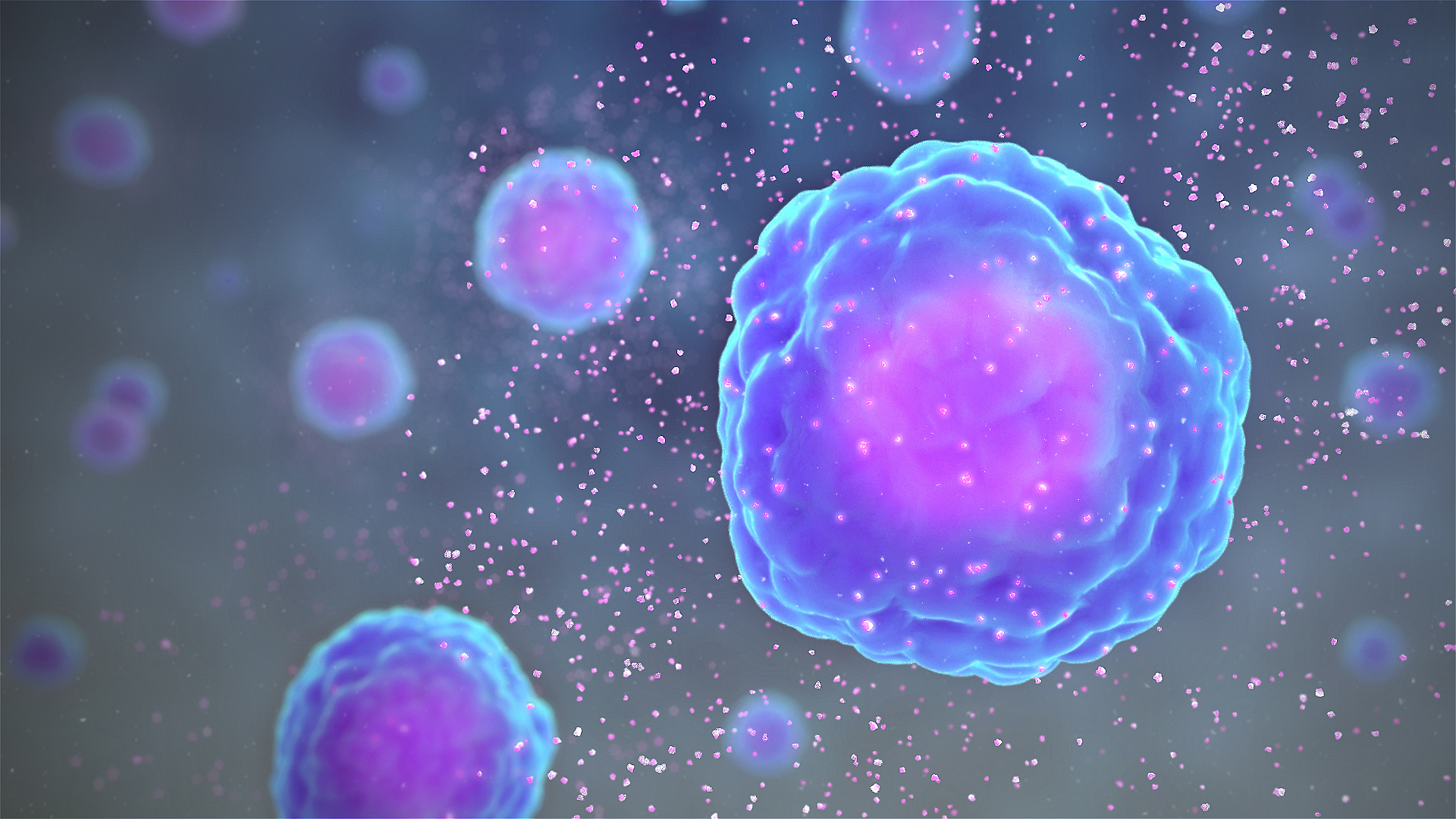|
ZAP70
ZAP-70 (Zeta-chain-associated protein kinase 70) is a protein normally expressed near the surface membrane of lymphocytes (T cells, natural killer cells, and a subset of B cells). It is most prominently known to be recruited upon antigen binding to the T cell receptor (TCR), and it plays a critical role in T cell signaling. ZAP-70 was initially discovered in TCR-stimulated Jurkat cells, an immortal line of human T lymphocytes, in 1991. Its molecular weight is 70 kDa, and it is a member of the protein-tyrosine kinase family and is a close homolog of SYK. SYK and ZAP70 share a common evolutionary origin and split from a common ancestor in the jawed vertebrates. The importance of ZAP-70 in T cell activation was determined when comparing ZAP-70 expression in patients with SCID (severe combined immunodeficiency). ZAP-70 deficient individuals were found to have no functioning T cells in their peripheral blood, suggesting that ZAP-70 is a critical component of T cell activation and ... [...More Info...] [...Related Items...] OR: [Wikipedia] [Google] [Baidu] |
ZAP70 Deficiency
ZAP70 deficiency, or ZAP70 deficient SCID, is a rare autosome, autosomal dominance (genetics), recessive form of severe combined immunodeficiency (SCID) resulting in a lack of CD8+ T cells. People with this disease lack the capability to fight infections, and it is fatal if untreated. It is cause by a mutation in the ZAP70 gene. Presentation Children with this condition typically present with infections and skin rashes. Unlike many forms of SCID, absolute lymphocyte count is normal and thymus is present. Cause ZAP70 deficiency SCID is caused by a mutation is the ZAP70 gene, which is involved in the development of T cells. Diagnosis It is characterized by a lack of CD8+ T cells and the presence of circulating CD4+ T cells which are unresponsive to T-cell receptor (TCR)-mediated stimuli. Diagnosis is usually made within the first six months of life. Genetic testing is required. Treatment Hematopoietic stem cell transplantation is the only known cure for ZAP70 deficient SCID. Ep ... [...More Info...] [...Related Items...] OR: [Wikipedia] [Google] [Baidu] |
Tyrosine-protein Kinase SYK
Tyrosine-protein kinase SYK, also known as spleen tyrosine kinase, is an enzyme which in humans is encoded by the ''SYK'' gene. Function SYK, along with ZAP70, is a member of the Syk family of tyrosine kinases. These cytoplasmic non-receptor tyrosine kinases share a characteristic dual SH2 domain separated by a linker domain. However, activation of SYK relies less on phosphorylation by Src family kinases than ZAP70. SYK and ZAP70 share a common evolutionary origin and split from a common ancestor in the jawed vertebrates. While Syk and ZAP70 are primarily expressed in hematopoietic tissues, a variety of tissues express Syk. Within B and T cells, respectively, Syk and ZAP70 transmit signals from the B-cell receptor and T-cell receptor. Syk plays a similar role in transmitting signals from a variety of cell surface receptors including CD74, Fc receptor, and integrins. Function during development Mice that lack Syk completely (Syk−/−, Syk-knockout) die during embryonic d ... [...More Info...] [...Related Items...] OR: [Wikipedia] [Google] [Baidu] |
Linker For Activation Of T Cells
The Linker for activation of T cells, also known as linker of activated T cells or LAT, is a protein involved in the T-cell receptor, T-cell antigen receptor signal transduction pathway which in humans is encoded by the ''LAT'' gene. Alternative splicing results in multiple transcript variants encoding different isoforms. Function The LAT protein encoded by the gene of the same name, plays a key role in the diversification of T cell signaling pathways following activation of the T-cell antigen receptor (T-cell receptor, TCR) signal transduction pathway, which is first catalyzed by TCR binding to MHC class II. LAT is a transmembrane protein localizes to lipid rafts (also known as glycosphingolipid-enriched microdomains or GEMs) and acts as a docking site for SH2 domain-containing proteins. Upon phosphorylation, this protein recruits multiple Signal transducing adaptor protein, adaptor proteins and downstream signaling molecules into multimolecular signaling complexes located nea ... [...More Info...] [...Related Items...] OR: [Wikipedia] [Google] [Baidu] |
T Helper Cell
The T helper cells (Th cells), also known as CD4+ cells or CD4-positive cells, are a type of T cell that play an important role in the adaptive immune system. They aid the activity of other immune cells by releasing cytokines. They are considered essential in B cell Immunoglobulin class switching, antibody class switching, breaking Cross-presentation, cross-tolerance in dendritic cells, in the activation and growth of cytotoxic T cells, and in maximizing bactericidal activity of phagocytes such as macrophages and neutrophils. CD4+ cells are mature Th cells that express the surface protein CD4. Genetic variation in regulatory elements expressed by CD4+ cells determines susceptibility to a broad class of autoimmune diseases. Structure and function Th cells contain and release cytokines to aid other immune cells. Cytokines are small protein mediators that alter the behavior of target cells that express Receptor (biochemistry), receptors for those cytokines. These cells help polar ... [...More Info...] [...Related Items...] OR: [Wikipedia] [Google] [Baidu] |
Immunoreceptor Tyrosine-based Activation Motif
An immunoreceptor tyrosine-based activation motif (ITAM) is a conserved sequence of four amino acids that is repeated twice in the cytoplasmic tails of non-catalytic tyrosine-phosphorylated receptors, cell-surface proteins found mainly on immune cells. Its major role is being an integral component for the initiation of a variety of signaling pathway and subsequently the activation of immune cells, although different functions have been described, for example an osteoclast maturation. Structure The motif contains a tyrosine separated from a leucine or isoleucine by any two other amino acids, giving the signature YxxL/I. Two of these signatures are typically separated by between 6 and 8 amino acids in the cytoplasmic tail of the molecule (YxxL/Ix(6-8)YxxL/I). However, in various sources, this consensus sequence differs, mainly in the number of amino acids between individual signatures. Apart from ITAMs which have the structure described above, there is also a variety of proteins c ... [...More Info...] [...Related Items...] OR: [Wikipedia] [Google] [Baidu] |
CD3-zeta
T-cell surface glycoprotein CD3 zeta chain also known as T-cell receptor T3 zeta chain or CD247 (Cluster of Differentiation 247) is a protein that in humans is encoded by the ''CD247'' gene. Some older literature mention a similar protein called "CD3 eta" in mice. It is now understood to be an isoform differing in the last exon. Genomics The gene is located on the long arm of chromosome 1 at location 1q22-q25 on the Crick (negative) strand. The encoded protein is 164 amino acids long with a predicted weight of 18.696 kilo Daltons. Function T-cell receptor zeta (ζ), together with T-cell receptor alpha/beta and gamma/delta heterodimers and CD3-gamma, -delta, and -epsilon, forms the T-cell receptor-CD3 complex. The zeta chain plays an important role in coupling antigen recognition to several intracellular signal-transduction pathways. Low expression of the antigen results in impaired immune response. Two alternatively spliced transcript variants encoding distinct isoforms ... [...More Info...] [...Related Items...] OR: [Wikipedia] [Google] [Baidu] |
SH2-domains
The SH2 (Src Homology 2) domain is a structurally conserved protein domain contained within the Src oncoprotein and in many other intracellular signal-transducing proteins. SH2 domains bind to phosphorylated tyrosine residues on other proteins, modifying the function or activity of the SH2-containing protein. The SH2 domain may be considered the prototypical modular protein-protein interaction domain, allowing the transmission of signals controlling a variety of cellular functions. SH2 domains are especially common in adaptor proteins that aid in the signal transduction of receptor tyrosine kinase pathways. Structure and interactions SH2 domains contain about 100 amino acid residues and exhibit a central antiparallel β-sheet centered between two α-helices. Binding to phosphotyrosine-containing peptides involves a strictly-conserved Arg residue that pairs with the negatively-charged phosphate on the phosphotyrosine, and a surrounding pocket that recognizes flanking seque ... [...More Info...] [...Related Items...] OR: [Wikipedia] [Google] [Baidu] |
T Cells
T cells (also known as T lymphocytes) are an important part of the immune system and play a central role in the adaptive immune response. T cells can be distinguished from other lymphocytes by the presence of a T-cell receptor (TCR) on their cell surface. T cells are born from hematopoietic stem cells, found in the bone marrow. Developing T cells then migrate to the thymus gland to develop (or mature). T cells derive their name from the thymus. After migration to the thymus, the precursor cells mature into several distinct types of T cells. T cell differentiation also continues after they have left the thymus. Groups of specific, differentiated T cell subtypes have a variety of important functions in controlling and shaping the immune response. One of these functions is immune-mediated cell death, and it is carried out by two major subtypes: CD8+ "killer" (cytotoxic) and CD4+ "helper" T cells. (These are named for the presence of the cell surface proteins CD8 or CD4.) CD8+ ... [...More Info...] [...Related Items...] OR: [Wikipedia] [Google] [Baidu] |
Tyrosine Kinase
A tyrosine kinase is an enzyme that can transfer a phosphate group from ATP to the tyrosine residues of specific proteins inside a cell. It functions as an "on" or "off" switch in many cellular functions. Tyrosine kinases belong to a larger class of enzymes known as protein kinases which also attach phosphates to other amino acids such as serine and threonine. Phosphorylation of proteins by kinases is an important mechanism for communicating signals within a cell (signal transduction) and regulating cellular activity, such as cell division. Protein kinases can become mutated, stuck in the "on" position, and cause unregulated growth of the cell, which is a necessary step for the development of cancer. Therefore, kinase inhibitors, such as imatinib and osimertinib, are often effective cancer treatments. Most tyrosine kinases have an associated protein tyrosine phosphatase, which removes the phosphate group. Reaction Protein kinases are a group of enzymes that possess a ca ... [...More Info...] [...Related Items...] OR: [Wikipedia] [Google] [Baidu] |
Cytokine
Cytokines () are a broad and loose category of small proteins (~5–25 kDa) important in cell signaling. Cytokines are produced by a broad range of cells, including immune cells like macrophages, B cell, B lymphocytes, T cell, T lymphocytes and mast cells, as well as Endothelium, endothelial cells, fibroblasts, and various stromal cells; a given cytokine may be produced by more than one type of cell. Due to their size, cytokines cannot cross the lipid bilayer of cells to enter the cytoplasm and therefore typically exert their functions by interacting with specific cytokine receptor, cytokine receptors on the target cell surface. Cytokines are especially important in the immune system; cytokines modulate the balance between humoral immunity, humoral and cell-mediated immunity, cell-based immune responses, and they regulate the maturation, growth, and responsiveness of particular cell populations. Some cytokines enhance or inhibit the action of other cytokines in complex way ... [...More Info...] [...Related Items...] OR: [Wikipedia] [Google] [Baidu] |
Src Family Kinase
Src kinase family is a family of non-receptor tyrosine kinases that includes nine members: Src (gene), Src, YES1, Yes, FYN, Fyn, and FGR (gene), Fgr, forming the SrcA subfamily, Lck, HCK, Hck, Tyrosine-protein kinase BLK, Blk, and Lyn (Src family Kinase), Lyn in the SrcB subfamily, and FRK (gene), Frk in its own subfamily. Frk has homologs in invertebrates such as flies and worms, and Src homologs exist in organisms as diverse as unicellular choanoflagellates, but the SrcA and SrcB subfamilies are specific to vertebrates. Src family kinases contain six conserved domains: a N-terminal Myristoylation, myristoylated segment, a SH2 domain, a SH3 domain, a linker region, a tyrosine kinase domain, and C-terminal tail. Src family kinases interact with many cellular cytosolic, nuclear and membrane proteins, modifying these proteins by phosphorylation of tyrosine residues. A number of substrates have been discovered for these enzymes. Deregulation, including constitutive activation or ... [...More Info...] [...Related Items...] OR: [Wikipedia] [Google] [Baidu] |
Lymphocyte Cytosolic Protein 2
Lymphocyte cytosolic protein 2 (SH2 domain containing leukocyte protein of 76kDa), also known as LCP2 or SLP-76, is a signal-transducing adaptor protein expressed in T cells and myeloid cells and is important in the signaling of T-cell receptors (TCRs). As an adaptor protein, SLP-76 does not have catalytic functions, primarily binding other signaling proteins to form larger signaling complexes. It is a key component of the signaling pathways of receptors with immunoreceptor tyrosine-based activation motifs (ITAMs) such as T-cell receptors, its precursors, and receptors for the Fc regions of certain antibodies. SLP-76 is expressed in T-cells and related lymphocytes like natural killer cells. Structure and function The amino acid sequence of the protein has a central domain with a high concentration of prolines, as well as domains at the amino-terminal and carboxy-terminal of the amino acid sequence. The PDB file 1H3H depicts the SH3 domain of GRAP2 in complex with an RSTK- ... [...More Info...] [...Related Items...] OR: [Wikipedia] [Google] [Baidu] |



